Introduction
Rooster Fights Game Download The world of competitive games has evolved over the years, encompassing a vast range of formats and genres. Among these, the Rooster Fights Game stands out as a fascinating blend of strategy, excitement, and cultural significance. Inspired by the traditional practice of cockfighting, where roosters are pitted against each other in a physical contest, the Rooster Fights Game has transcended its origins, incorporating elements of simulation, strategy, and fantasy to become a popular and engaging gaming experience. This essay explores the mechanics, cultural roots, social impact, and controversies surrounding the Rooster Fights Game, shedding light on its significance in the world of gaming.
Historical and Cultural Background
The concept of rooster fighting, or cockfighting, dates back thousands of years and has been a part of many cultures across the world. It was practiced in ancient civilizations, including Greece, Rome, China, and India, as well as in various Southeast Asian countries. Rooster fighting was not only a popular form of entertainment but also a symbol of social status and male competitiveness. However, over time, the practice came to be seen as inhumane and was outlawed in many parts of the world.
Despite its controversial nature, the traditions surrounding rooster fights have influenced modern games, including those like the Rooster Fights Game. The game draws inspiration from the dramatic battles between roosters, which were often highly ritualized and carried with them a sense of grandeur and competition. In the digital age, these battles have been transformed into a form of entertainment that preserves the intense competition and strategic elements of traditional cockfighting while removing the physical harm to animals.
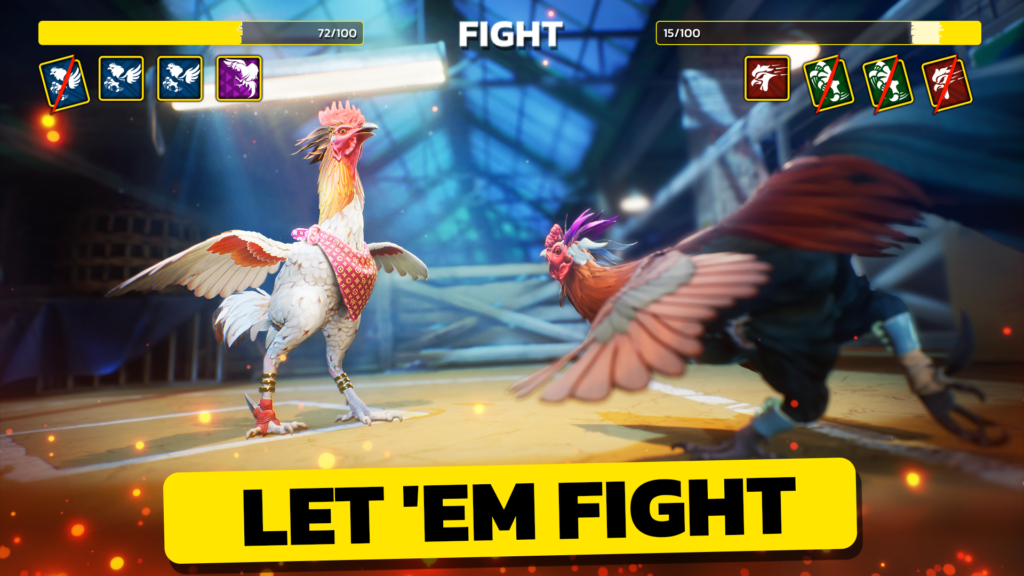
Game Mechanics and Features
Rooster Fights Game Download At the heart of the Rooster Fights Game is the concept of a digital rooster battle, where players train, upgrade, and control their roosters in a virtual arena. Much like traditional cockfights, the game centers on one-on-one matches between two roosters. However, the game elevates this simple concept through several gameplay mechanics that provide depth and strategy.
- Training and Development: Players start by selecting a rooster, each with unique traits and abilities. These roosters can be trained through various in-game activities, including strength exercises, agility drills, and combat simulations. Over time, the rooster’s attributes improve, increasing its chances of winning battles.
- Battle Arena: The central feature of the game is the battle arena, where players’ roosters face off against others. These arenas can range from simple, no-frills environments to elaborate, detailed settings that include obstacles and environmental factors that can affect the outcome of a fight. The battles themselves are a mix of real-time strategy and quick reflexes, as players must manage their rooster’s stamina, timing, and special moves.
- Tactics and Strategy: Unlike traditional cockfighting, where the outcome is determined by physical strength alone, the Rooster Fights Game incorporates a deep strategic layer. Players must choose the right timing for attacks, block incoming strikes, and use their rooster’s special abilities to outsmart the opponent. This makes the game more about skill and preparation rather than brute force, offering a level of complexity that appeals to gamers seeking more than just a simple combat game.
- Customizable Roosters: One of the most engaging aspects of the Rooster Fights Game is the customization options available to players. Roosters can be equipped with a variety of feathers, talons, and accessories, each offering different buffs and enhancements. Players can also choose from various fighting styles, which affect how the rooster behaves in battle. The ability to modify and personalize roosters adds an extra layer of investment and excitement to the game.
- Multiplayer and Tournaments: Many Rooster Fights Games feature online multiplayer modes where players can challenge others around the world. In these modes, players participate in tournaments or casual battles to test their skills and roosters. Online rankings and leaderboards create a competitive environment, motivating players to improve and refine their strategies.
- Virtual Economy and Rewards: The game often includes a virtual economy, where players can earn in-game currency through victories, which can then be used to buy upgrades, new roosters, or cosmetic items. This aspect of the game adds another level of progression and rewards players for their time and effort.
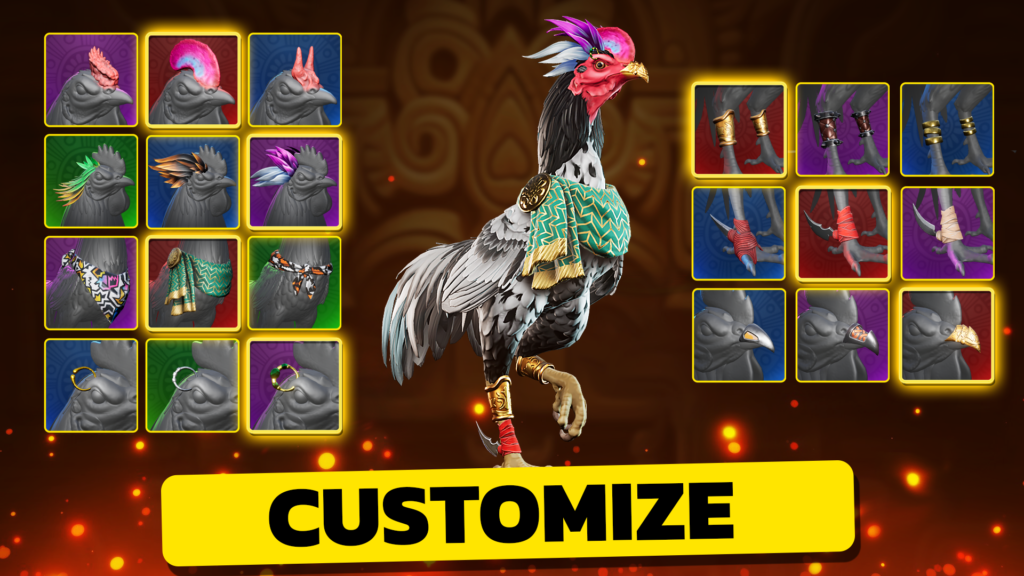
Cultural Impact
The Rooster Fights Game represents a modern evolution of an ancient tradition, offering a virtual alternative to a controversial practice. As video games have become a dominant form of entertainment across the globe, games like the Rooster Fights Game have managed to create new avenues for cultural expression and engagement. By translating the traditional practice of rooster fighting into a digital format, the game can be enjoyed by a wide audience without promoting animal cruelty.
However, the game also has the potential to stir up debates regarding the ethics of glorifying or simulating activities that are harmful to animals in real life. For some, it may be seen as a harmless form of entertainment, while for others, it could evoke negative associations with the real-world practice of cockfighting. The game, therefore, exists at the intersection of tradition and modernity, offering both entertainment and a point of contention for players and critics alike.
Ethical Considerations and Controversies
Despite the game’s popularity, it is not without controversy. Critics argue that even though no animals are harmed in the gameplay, the representation of rooster fights may still glamorize and normalize the practice. For animal rights activists and those opposed to cockfighting, the game can be seen as trivializing an activity that causes real harm to animals.
Rooster Fights Game Download In some regions, the game has faced bans or restrictions due to its controversial nature. Governments and gaming platforms have implemented rules to prevent the game from being marketed or sold in areas where cockfighting is illegal or considered unethical. These legal and ethical debates illustrate the broader concerns about the portrayal of violence in digital media and the responsibility of game developers in shaping the content they create.
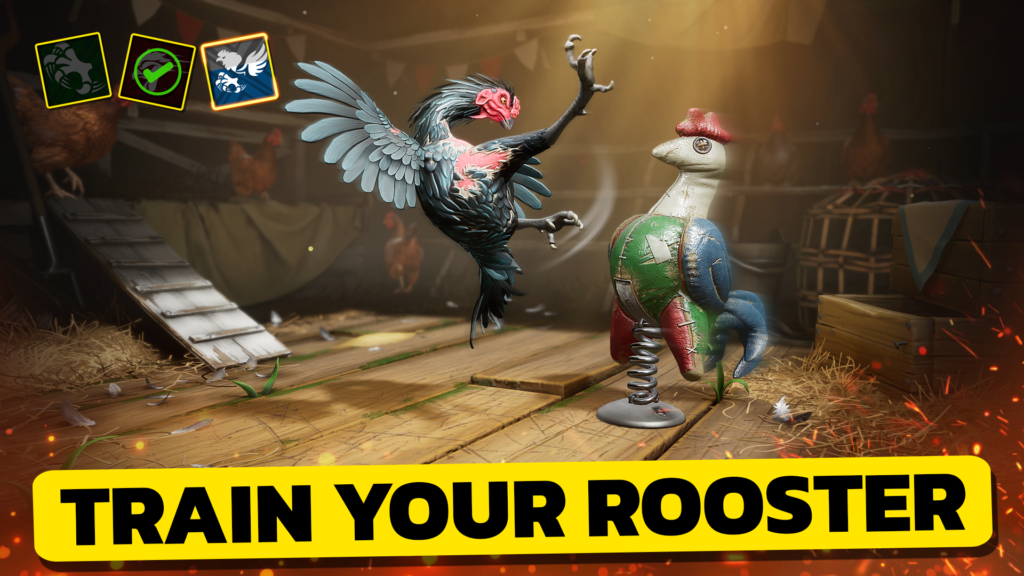
Graphics of the Rooster Fights Game
Graphics are a key component in modern video games, playing a vital role in immersing players into the virtual world and enhancing the overall experience. For games like the Rooster Fights Game, where the primary focus is on combat and strategy, graphics are integral not only to gameplay but also to the game’s thematic design. The visual presentation of the game, including character models, environments, animations, and special effects, can elevate the excitement, challenge, and emotional engagement that players experience.
This essay delves into the graphics of the Rooster Fights Game, examining how visual design influences gameplay, player engagement, and the overall gaming experience.
1. Character Models and Rooster Design
At the core of the Rooster Fights Game are the roosters themselves. The graphical quality of these characters is crucial, as they represent the player’s investment in the game. The design of the roosters focuses on their aesthetic appeal, physical attributes, and the distinctiveness of each bird.
- Realistic and Stylized Models: Depending on the game, rooster designs can either be highly realistic or adopt a more stylized, cartoonish look. In realistic designs, players expect to see intricate details in the feathers, beaks, talons, and eye features. A rooster may have textures that mimic real-life feathers, varying shades of color, and visible signs of wear and tear from battle. On the other hand, a stylized approach might use exaggerated features, colorful feathers, and an almost anthropomorphic quality to the roosters. This artistic direction allows for greater creativity and can enhance the game’s appeal to a wider audience.
- Customization Options: Many Rooster Fights games allow players to customize their roosters with different cosmetic upgrades. These can range from changing the bird’s feathers, adding new weapons (like talon upgrades), or even dressing them in special accessories. The graphics used to depict these customizations should reflect the unique traits and enhancements added, ensuring that each rooster is distinguishable and visually appealing. The customization features not only increase player engagement but also provide a visual sense of progression as roosters evolve.
- Animation and Movement: Rooster animations are critical in bringing the game to life. From the swift flapping of wings to the precise movements during attacks, the animation of roosters must feel fluid and dynamic. Movements during battle, including jumping, pecking, dodging, and striking, should be well-executed and match the rooster’s style and personality. Realistic physics, such as the rooster’s feathers reacting to movement or wind effects, can further elevate the graphical quality of the game.
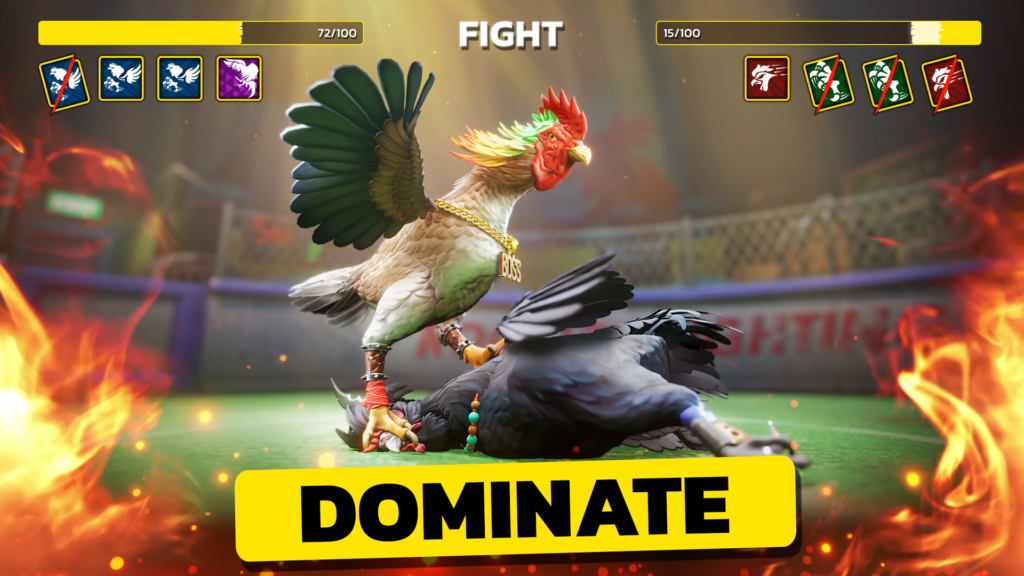
2. Battle Arenas and Environmental Design
The battle arenas where the rooster fights take place are another critical aspect of the game’s graphics. These environments not only provide the backdrop for the action but can also influence gameplay with their design. From traditional cockfighting rings to elaborate fantasy arenas, the environment must match the tone and style of the game while providing players with an engaging and interactive space for combat.
- Arena Variety: Different arenas can offer varying levels of complexity. A simple arena might have a circular, dirt ring, with minimal distractions. More advanced arenas, however, may feature dynamic elements such as obstacles (e.g., crates, barriers), shifting terrain, and even environmental hazards like fire or water. The graphics used to create these arenas should balance realism with artistic flair, maintaining the visual appeal of the game without overwhelming the player with unnecessary details.
- Interactive Environments: In some Rooster Fights games, the environment itself plays a role in the fight. For example, players might use objects in the arena to their advantage, such as hiding behind structures or triggering environmental effects (e.g., explosive barrels or smoke clouds). This adds an additional layer of strategy and interactivity to the gameplay, and the graphical design of these elements must be well-integrated into the game world.
- Lighting and Atmosphere: Lighting effects, shadows, and overall atmosphere are crucial in setting the tone for the game. A battle at night with a brightly lit stadium creates a different mood than one fought under the harsh glare of midday. Dynamic weather effects like rain, wind, or fog can also affect the visual impact of the game, making the environment feel alive and changing. Atmospheric effects can enhance the intensity of a fight, highlighting the tension of a rooster’s last stand or the excitement of a critical move.
3. Special Effects and Visual Effects During Combat
In combat, the Rooster Fights Game should employ striking visual effects that enhance the impact of each attack, skill, or special move. These special effects not only make each battle visually engaging but also signal key moments within the match, such as powerful blows or counterattacks.
- Impact Effects: Every time one rooster strikes another, there should be a noticeable visual cue to signify the force of the blow. This could take the form of feathers flying off, sparks of energy, or even dynamic lighting effects. The more intense the action, the more pronounced these effects should be, adding a sense of weight and excitement to each fight.
- Rooster Abilities and Special Moves: Many Rooster Fights Games include special moves or abilities that players can trigger during battle, such as a spinning attack or a powerful talon strike. These moves are often accompanied by visually distinct effects, such as glowing feathers, energy surges, or trail effects, which help to convey the power of the move. These effects contribute to the game’s overall spectacle, heightening the sense of excitement and anticipation.
- Visual Feedback and HUD: The Heads-Up Display (HUD) is another graphical element that helps players track the progress of the battle. The health bars of the roosters, stamina gauges, and special ability meters should be clearly displayed but integrated into the game world so as not to clutter the screen. In addition, visual feedback such as blinking health bars or flashing indicators for critical strikes can signal to the player when an attack has successfully landed or when the rooster is in danger.
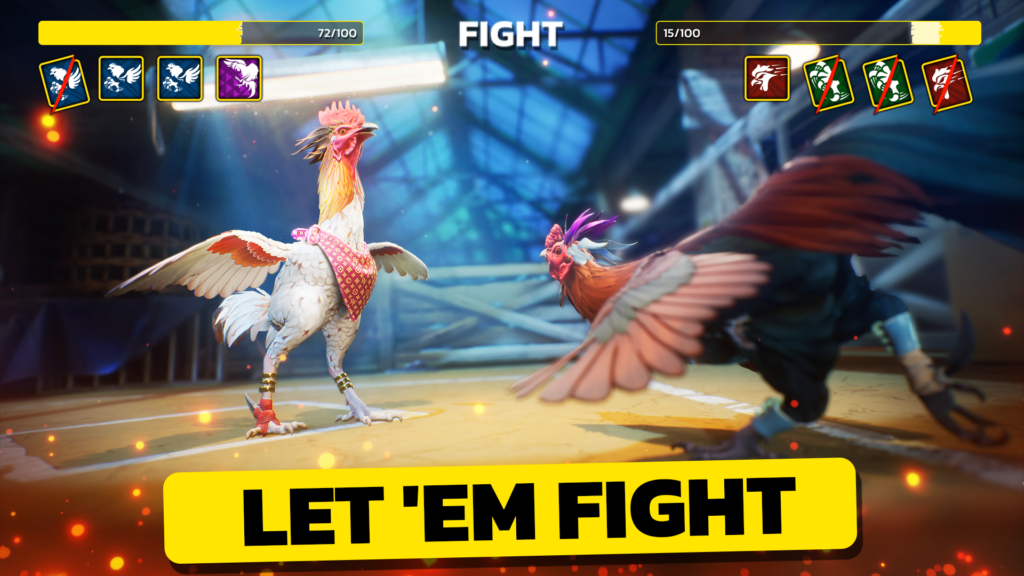
4. User Interface (UI) Design
The user interface (UI) of the Rooster Fights Game should be designed to be intuitive, ensuring that players can focus on the action without distraction. The interface includes menus, battle controls, and feedback systems, all of which need to be designed to support the game’s aesthetics and functionality.
- Menus and Navigation: In between fights, players often navigate through menus to manage their roosters, upgrade their stats, or engage in multiplayer modes. The menus should be visually consistent with the game’s design and easy to navigate. Elegant but simple graphics, smooth transitions, and clear icons can help make this aspect of the game enjoyable and stress-free.
- Combat Controls: The controls during the battle must be fluid, with on-screen prompts or buttons that guide the player without obstructing the action. The graphics used for these prompts should be subtle, ensuring that they don’t distract from the main gameplay but remain easy to understand when needed.
5. Artistic Style and Visual Aesthetics
Finally, the overall artistic style of the Rooster Fights Game contributes significantly to the player experience. Whether the game is adopting a realistic, stylized, or cartoonish art style, consistency across all graphical elements ensures that the game world feels cohesive.
- Color Palette: The use of colors plays a crucial role in establishing the mood and tone of the game. Vibrant and saturated colors may make the game feel energetic and lively, while muted tones could create a more dramatic or gritty atmosphere. The color palette should also be used to distinguish between different types of roosters, with certain colors or designs indicating a rare or powerful rooster.
- Character and Environment Design Consistency: The art direction should also maintain a visual consistency between characters, environments, and animations. Whether the design leans toward realism or abstraction, all aspects of the game should align with the overall theme, creating a seamless experience that pulls the player deeper into the world of rooster fighting.
Conclusion
Rooster Fights Game Download The Rooster Fights Game represents an intriguing blend of tradition, strategy, and entertainment, offering players a chance to experience a digital version of a practice that has long been steeped in cultural history. Through its mechanics, customization options, and online gameplay, the game creates an engaging and competitive environment that appeals to a broad audience. However, it also raises important ethical questions about the portrayal of violence, the glamorization of harmful practices, and the responsibility of game creators to consider the social impact of their designs.
GAME LINK
In the end, the Rooster Fights Game is a complex digital experience that reflects the ways in which traditional cultural practices can be reimagined and transformed in the modern gaming world. Whether viewed as an innocent pastime or as a controversial subject, it undoubtedly offers a thought-provoking exploration of how video games can shape our perceptions of both history and contemporary entertainment.


